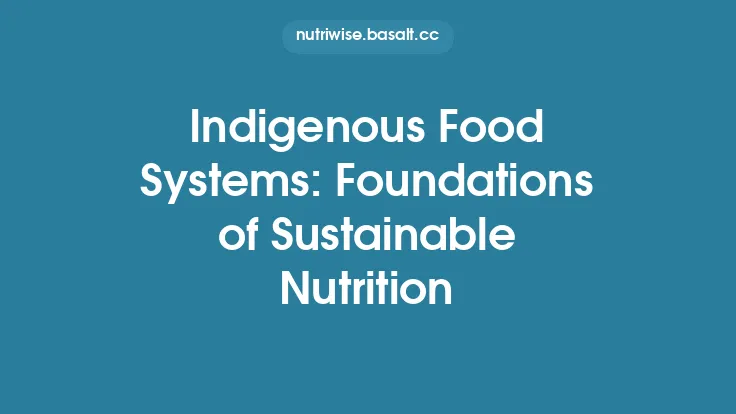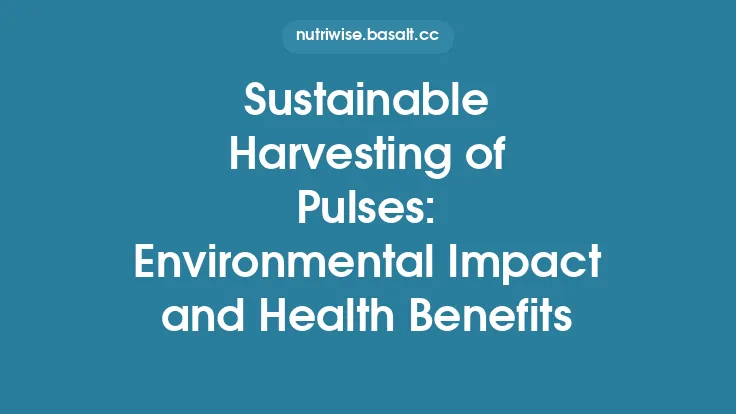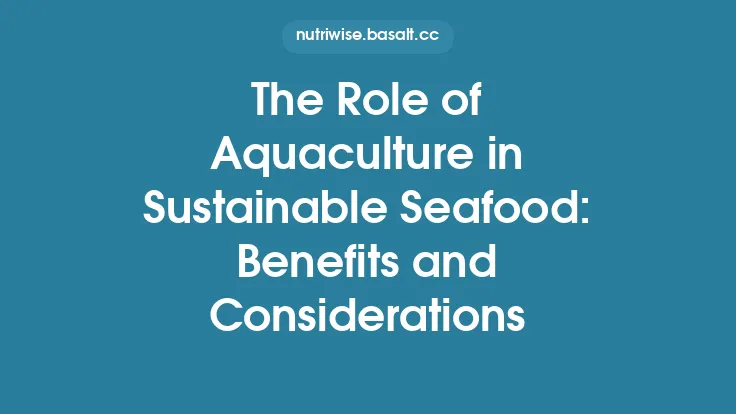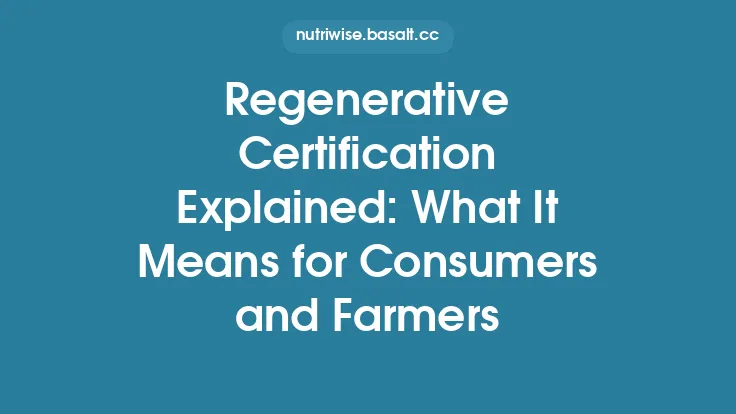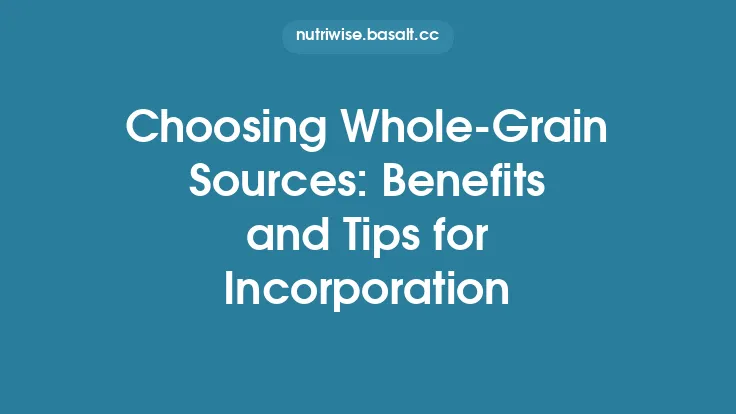Regenerative agriculture is more than a set of isolated techniques; it is a holistic philosophy that re‑imagines how we produce food, manage land, and interact with the planet’s natural systems. By placing living soil, biodiversity, and ecosystem resilience at the center of farm design, regenerative practices aim to restore the health of the land while delivering nutritious food, stable livelihoods, and climate benefits. This article unpacks the foundational principles that define regenerative agriculture and explores the wide‑ranging advantages it offers to sustainable food systems.
Core Principles of Regenerative Agriculture
Regenerative agriculture rests on a handful of interrelated tenets that together create a self‑reinforcing loop of ecological health and productivity.
| Principle | What It Means | Why It Matters |
|---|---|---|
| Minimize Soil Disturbance | Reduce or eliminate mechanical tillage, preserving soil structure and the web of organisms that live within it. | Undisturbed soils retain carbon, support water infiltration, and foster robust microbial communities. |
| Keep Living Roots in the Ground | Ensure that plants maintain active root systems for as much of the year as possible. | Roots exude sugars that feed soil microbes, create channels for water, and lock carbon into stable forms. |
| Enhance Biodiversity | Cultivate a mosaic of plant species, habitats, and functional groups (e.g., pollinators, predatory insects, soil fauna). | Diverse ecosystems are more resilient to pests, diseases, and climate extremes, and they provide a broader suite of ecosystem services. |
| Close Nutrient Loops | Recycle nutrients on‑farm through animal manure, crop residues, and other organic inputs, reducing reliance on external synthetic fertilizers. | Closed loops lower input costs, diminish runoff, and keep essential nutrients within the soil food web. |
| Integrate Livestock Thoughtfully | Use animals as mobile composters and grazers, timing their presence to complement plant growth cycles. | Managed livestock can stimulate root growth, distribute manure evenly, and increase soil organic matter without degrading pasture health. |
| Adopt Adaptive Management | Continuously monitor ecological indicators and adjust practices based on observed outcomes. | Adaptive feedback loops ensure that management stays aligned with ecological goals and can respond to changing conditions. |
These principles are not prescriptive checklists; rather, they provide a flexible framework that can be tailored to a wide range of climates, soils, and production goals—from large grain farms to specialty vegetable operations.
How Regenerative Practices Rebuild Soil Organic Matter
Soil organic matter (SOM) is the cornerstone of a healthy, productive agro‑ecosystem. Regenerative agriculture nurtures SOM through several synergistic pathways:
- Root‑Derived Carbon
Living roots release exudates—simple sugars, amino acids, and organic acids—that feed a diverse community of bacteria, fungi, and protozoa. These microbes, in turn, transform plant residues into stable humus, a key component of SOM.
- Microbial Biomass Expansion
By limiting disturbance and providing continuous organic inputs, regenerative farms encourage the proliferation of mycorrhizal fungi and nitrogen‑fixing bacteria. These organisms create protective coatings around soil particles, forming aggregates that physically protect carbon from oxidation.
- Residue Retention
Leaving crop residues on the surface or incorporating them gently into the soil adds a steady stream of carbon. Over time, this “slow‑burn” approach builds a layered organic horizon that improves water holding capacity and nutrient availability.
- Animal Manure Integration
When livestock are incorporated strategically, their manure delivers a balanced mix of carbon, nitrogen, phosphorus, and micronutrients. The organic matrix of manure also serves as a habitat for beneficial microbes, accelerating SOM formation.
- Reduced Oxidative Stress
Minimal tillage limits the exposure of soil organic carbon to oxygen, slowing the rate of microbial respiration that would otherwise convert carbon to CO₂. This preservation effect is especially pronounced in soils with high aggregate stability.
Collectively, these mechanisms increase the quantity and quality of SOM, which translates into stronger soil structure, higher nutrient retention, and greater resilience to drought and erosion.
Climate Benefits and Carbon Management
Regenerative agriculture offers a powerful lever for climate mitigation, primarily through the sequestration of atmospheric carbon dioxide (CO₂) into stable soil carbon pools.
- Carbon Drawdown
By fostering deep, extensive root systems and protecting soil aggregates, regenerative farms can capture several tons of CO₂ per hectare each year. Over decades, this cumulative sequestration can offset a substantial portion of a farm’s greenhouse gas (GHG) emissions.
- Reduced Synthetic Input Emissions
Synthetic nitrogen fertilizers are energy‑intensive to produce, releasing CO₂ and nitrous oxide (N₂O) during manufacturing and application. Closed nutrient loops lower the need for these inputs, directly cutting GHG emissions.
- Methane Mitigation via Managed Livestock
Thoughtful integration of livestock—where animals graze on cover vegetation and their manure is rapidly incorporated—can reduce enteric methane emissions per unit of product compared with conventional confinement systems.
- Enhanced Climate Resilience
Soils rich in organic matter retain more water and buffer temperature fluctuations, helping crops withstand heatwaves, heavy rains, and prolonged dry spells. This resilience reduces the likelihood of crop failure, thereby stabilizing food supplies under a changing climate.
- Potential for Carbon Credit Generation
Robust measurement protocols enable farms to quantify their carbon sequestration and participate in emerging carbon markets, creating an additional revenue stream that incentivizes regenerative adoption.
Water Use Efficiency and Soil Structure
While water‑management strategies themselves fall outside the scope of this discussion, it is worth noting that regenerative practices inherently improve the soil’s ability to capture, store, and release water:
- Improved Infiltration
Well‑aggregated soils with high organic matter content develop macropores that allow rainwater to percolate quickly, reducing surface runoff and erosion.
- Higher Water Holding Capacity
Organic matter acts like a sponge, holding water within its matrix and making it available to plant roots during dry periods. This reduces the need for supplemental irrigation.
- Reduced Evapotranspiration Losses
A dense, living root network shades the soil surface and creates a microclimate that curtails rapid water loss to the atmosphere.
These hydrological benefits are natural by‑products of the regenerative focus on soil health and biodiversity, reinforcing the system’s overall sustainability.
Economic and Social Advantages
Regenerative agriculture is not solely an ecological endeavor; it also delivers tangible economic and community benefits.
- Lower Input Costs
By reducing dependence on synthetic fertilizers, pesticides, and intensive tillage equipment, farmers can cut operational expenses. Organic residues, animal manure, and on‑farm biodiversity serve as low‑cost inputs.
- Enhanced Yield Stability
Diverse, resilient ecosystems buffer crops against pest outbreaks and weather extremes, leading to more consistent yields over time. This stability is especially valuable in markets where price volatility can threaten farm viability.
- Premium Market Opportunities
Growing consumer awareness of sustainability creates demand for products grown under regenerative principles. While certification is a separate topic, many retailers and food service companies are willing to pay higher prices for demonstrably regenerative produce.
- Job Creation and Rural Development
Regenerative farms often require a broader skill set—soil science, animal husbandry, ecological monitoring—creating new employment opportunities in rural areas and fostering knowledge transfer.
- Community Health and Food Security
Healthier soils produce more nutrient‑dense crops, contributing to better public health outcomes. Moreover, resilient production systems help secure local food supplies, reducing reliance on distant, centralized supply chains.
Policy Landscape and Incentives
Governments and institutions worldwide are beginning to recognize the systemic value of regenerative agriculture and are shaping policies to support its expansion.
- Subsidies and Grants
Many agricultural ministries now offer financial assistance for practices that improve soil health, such as reduced‑till equipment purchases or on‑farm nutrient recycling projects.
- Carbon Pricing Mechanisms
Emerging carbon credit programs allow farmers to monetize the carbon sequestered in their soils, providing a direct economic incentive for regenerative transition.
- Research Funding
Public and private research bodies are allocating resources to study soil microbiomes, ecosystem services, and long‑term carbon dynamics, generating the scientific foundation needed for evidence‑based policy.
- Extension Services and Training
Extension agencies are updating curricula to include regenerative principles, offering workshops, field days, and digital resources that help producers adopt new practices.
- Regulatory Flexibility
Some jurisdictions are revising pesticide and fertilizer regulations to encourage integrated pest management and nutrient recycling, aligning legal frameworks with regenerative goals.
These policy tools, when coordinated effectively, can accelerate the scaling of regenerative agriculture while ensuring that environmental benefits are measured and verified.
Monitoring, Metrics, and Continuous Improvement
A cornerstone of regenerative agriculture is the systematic tracking of ecological and economic indicators. Robust monitoring enables farmers to verify progress, adapt practices, and communicate outcomes to stakeholders.
- Soil Organic Carbon (SOC) Testing
Periodic soil sampling and laboratory analysis provide quantitative data on carbon sequestration rates. Emerging rapid‑test kits and portable spectrometers are making SOC measurement more accessible.
- Biological Activity Indices
Metrics such as microbial respiration, enzyme activity, and earthworm counts serve as proxies for soil vitality. Increases in these indicators often precede observable improvements in crop performance.
- Biodiversity Surveys
Simple field observations—counting pollinator visits, tracking predator‑prey interactions, or mapping habitat patches—help gauge ecosystem health.
- Yield and Input Efficiency Ratios
Comparing output per unit of input (e.g., kilograms of grain per kilogram of fertilizer) highlights economic efficiency gains over time.
- Remote Sensing and GIS
Satellite imagery and drone‑based sensors can monitor vegetation vigor, canopy cover, and soil moisture at scale, providing a macro‑level view of farm health.
- Adaptive Management Cycles
Data collected from these metrics feed into a decision‑making loop: assess → adjust → re‑measure. This iterative process ensures that management remains aligned with regenerative objectives and can respond to emerging challenges such as pest pressure or climate anomalies.
Future Directions and Emerging Technologies
The regenerative agriculture movement is dynamic, continually integrating new scientific insights and technological tools to enhance its effectiveness.
- Digital Decision‑Support Platforms
Cloud‑based software that aggregates soil data, weather forecasts, and market information can guide real‑time management choices, optimizing timing for planting, grazing, and residue incorporation.
- Sensor Networks and IoT
Soil moisture probes, temperature loggers, and microbial activity sensors provide continuous, high‑resolution data streams, allowing farmers to fine‑tune practices without excessive labor.
- Microbial Inoculants and Bio‑Stimulants
Formulations containing beneficial bacteria, mycorrhizal fungi, or plant growth‑promoting compounds can accelerate soil health restoration, especially on degraded lands.
- Precision Application Technologies
Variable‑rate equipment can deliver organic amendments and livestock manure exactly where needed, reducing waste and maximizing ecological impact.
- Collaborative Data Platforms
Open‑source databases that compile farm‑level outcomes enable collective learning, benchmarking, and the identification of best practices across regions and production systems.
- Education and Knowledge Exchange
Virtual reality field tours, interactive MOOCs, and farmer‑to‑farmer mentorship programs are expanding the reach of regenerative knowledge, fostering a global community of practice.
These innovations, when aligned with the core regenerative principles, promise to deepen the impact of sustainable food systems and accelerate the transition toward a more resilient agricultural future.
Concluding Thoughts
Regenerative agriculture offers a comprehensive blueprint for rebuilding the health of our soils, revitalizing biodiversity, and delivering climate‑positive food production. By embracing minimal disturbance, continuous root presence, biodiversity enrichment, closed nutrient loops, thoughtful livestock integration, and adaptive management, producers can unlock a cascade of benefits—enhanced soil fertility, greater water efficiency, reduced input costs, and stronger community resilience.
The journey toward fully regenerative food systems is collaborative, requiring supportive policies, robust scientific research, and transparent monitoring. As technology advances and market demand for sustainable products grows, the regenerative paradigm stands poised to become a cornerstone of global agriculture, ensuring that the food we feed today nurtures the planet for generations to come.

